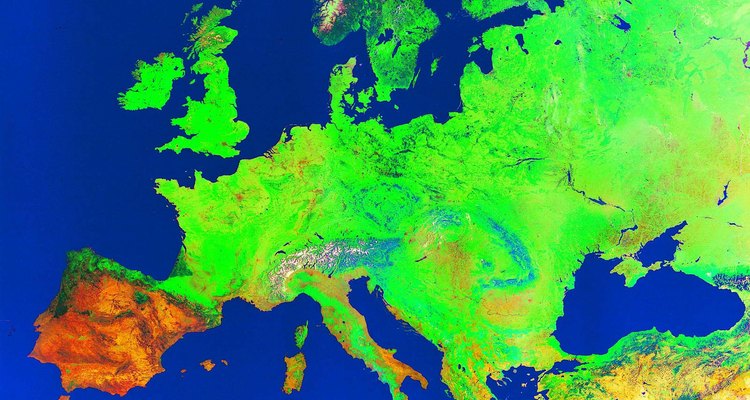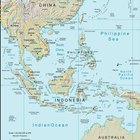
Digital Vision./Photodisc/Getty Images
In the United States it is common to hear someone refer to a trip to "Europe" or to "European culture," but the geographic region known as Europe is incredibly diverse without a common culture or diet. Still, some generalizations can be made about either, and the European diet has actually become more homogeneous over the past few decades.
European Culture

Jupiterimages/BananaStock/Getty Images
Europe consists of 50 countries, while the European Union, or EU, is made up of 27 member states at the time of publication. Countries in Europe are commonly associated with strong democratic principles, strong centralized governments and strong nationalism rooted in traditions that often can be traced back hundreds of years. As a general rule, countries in close proximity to one another share more traits than those farther away, though there are exceptions. According to the most recent EU quality of life poll. which was administered in 2007, there are significant differences in income across countries, though overall EU residents rate their satisfaction with life and general happiness at 7 and 7.5 out of 10, respectively. About 80 percent of people living in the EU say good health is a "very important" part of their overall quality of life, with 46 percent saying their health was "good" and 21 percent "very good."
European Diet as a Whole

deyangeorgiev/iStock/Getty Images
The relationship between diet and health cannot be overstated; although countries in Europe are different from one another, their diet has become more similar in recent decades. Research published in 2006 in "Public Health Nutrition" looked at the diets of countries in the EU and how those diets changed over time. In the early 1960s, several European countries had a diet more like that of the United States than elsewhere in Europe. Nowadays, diets in Europe have converged and are more like each other. Since 1960, countries in Northern Europe, which had previously shown high consumption of saturated fats and sugar, now consume less of each and more fruits and vegetables. Mediterranean countries, including Spain and Portugal, which in 1960 were eating high amounts of fruits and vegetables, now eat less of each and consume more cholesterol, saturated fat and sugar. The result is a coming together at the middle, so that Europeans reach minimum requirements for each food group, but eat too much overall, especially of saturated fat and cholesterol.
France

Sergey Borisov/iStock/Getty Images
Out of all European countries, France is probably the best known for its food. The image of the French restaurant and bakery, with attention to detail evident in each dish, is a common one in television and cinema. Unfortunately, even France does not appear to be immune to overall trends in the European diet. A 2010 study in the "British Journal of Nutrition" reported on changes to the French diet from 1999 to 2007. There appears to be two separate diets in France, with young adults eating similarly to Americans, focused on snacking and convenience, while only the older generation eats what is thought of as the traditional French diet. Overall, the French have transitioned to eating less dairy, meat, bread, potatoes, pastries and sugar over that time period, while eating more fruits and vegetables, rice and sweets like ice cream and chocolate.
Europe and Obesity

George Doyle/Valueline/Getty Images
As Europe as a whole moved toward a more common diet, somewhere between the Northern European diet and the Mediterranean, obesity rose as well. According to European research group Food and Health Research in Europe, or FAHRE, 10 percent of children and 20 percent of adults in the EU are obese, with those percentages expected to continue to increase. This is a dramatic rise from the turn of the 21st century, when the prevalence of obesity was very low. Numerous policies are attempting to curb the obesity epidemic in Europe, including five year action plans on food and nutrition by the European Office of the World Health Organization, a European Charter on Obesity that has been signed by nearly all 50 countries in Europe, various European and EU initiatives, along with the newly created European Commission Platform on Diet, Physical Activity and Health. Scientific research also is increasing. In 1979 there were about 1,000 studies published related to obesity, whereas in 2009 there were close to 12,000.
Related Articles

What Is an Asymmetrical Social ...

Mexican Dating Rules

Victorian Era Wedding Traditions

What Is a Multicultural Marriage?

Southeast Asian Diet & Nutrition

The History of Asian Food

The Impact of Petrarch

What Is a Family Crest?

Facial Hairstyles in the 1960s

Why Does the Wedding Ring Go on the 4th ...

A List of Foods From the Medieval Times

Can a Man Have a Close Friendship With ...

Croton Watches History

Relationship drama: why men suffer more ...

Paleo-Mediterranean Diet

Spanish Dating, Courtship & Marriage ...

About Colonial Desserts

List of High-Satiety Foods

Differences Between U.S. & European ...

What Is the Meaning of a Ring on the ...
References
- Eurofound: European Quality of Life Survey; 2007
- "Public Health Nutrition"; The Changing Structure of Diets in the European Union in Relation to Healthy Eating Guidelines; Josef Schmidhuber, et al.; 2006
- "British Journal of Nutrition"; Trends in Food and Nutritional Intakes of French Adults From 1999 to 2007: Results From the INCA Surveys; C. Dubuisson, et al; 2009
Writer Bio
Writing since 2004, Joe Smyser has contributed to the Centers for Disease Control and Prevention, the "European Journal of Public Health" and the "Journal of Biolaw and Business," among other publications and organizations. Smyser is a Ph.D. student in public health at UC San Diego and holds a Master of Public Health from San Diego State University.
Photo Credits
Digital Vision./Photodisc/Getty Images